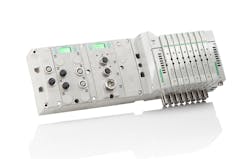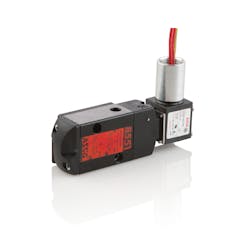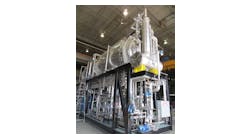Nearly a billion people worldwide lack basic water services and another billion lack safely managed drinking water, according to a United Nations Report on Water and Sanitation.1 And the problem is only getting worse: Currently, 17 countries and 33 of the world’s cities2 with populations above three million are living under extremely high water stress. The number of cities is expected to rise to 45 by 2030.
Desalination is one solution, but it is one of the most expensive alternatives, requiring extensive mechanical, biological and chemical treatment to create water fit for human consumption or even industrial/commercial use. The global desalination market is expected to reach a 7.8 percent combined annual growth rate (CAGR)3 through 2025 and provide 1 percent of the water we use, relying mainly on proven approaches like reverse osmosis (RO), electrodialysis, and multi-effect distillation (MED).
In addition to extensive water conservation efforts, which are the least expensive option, there are two cutting-edge alternatives looming on the horizon as possible ways to address the problem.
- Temperature swing solvent extraction (TSSE), which uses a solvent to extract freshwater more efficiently than other methods and at a fraction of the cost.
- Battery electrode deionization (BDI), in which electrodes are used to remove salt ions from the water.
Both are still in their infancy. It is yet to be determined whether they can continue to offer economic and environmental benefits when scaled up to the level needed for large-scale commercialization.
As a result, traditional desalination efforts remain the most commercially viable alternative to deal with this massive global water challenge. Fortunately, technology has risen to the occasion, offering a number of new ways to improve the performance, reliability, monitoring and environmental impact of desalination systems.
Automation and IoT Connectivity
Perhaps the key advance is enabled through the data collection and monitoring capabilities offered by the Internet of Things (IoT).
Admittedly, many of today’s older plants were designed primarily for manual and semi-automatic operation. However, several factors, including the requirement to increase output, quality, and efficiency, are driving desalination plants to increase their level of automation and IoT connectivity.
Plus, as they add new equipment that is IoT-enabled, plant operators will increasingly be able to capture data from sensors measuring pressure, temperature, level, flow, analytics (like pH), and wireless performance.
These new measurements will enable plant operators to monitor equipment remotely, improve plant performance, and identify opportunities for predictive maintenance. Those capabilities provide a variety of benefits, including improved water quality, greater reliability, reduced downtime, increased energy efficiency and enhanced waste removal.
Improved Water Quality
Using sensors deployed throughout the plant, facility operators will be able to monitor critical performance information, like conductivity, chlorine content, dissolved oxygen, turbidity, and particle index in real time.
Industrial IoT-enabled systems also include the ability to distribute key measurements to the appropriate managers in a plant. In fact, performance dashboards can be customized for individual job responsibilities.
Greater Reliability
Data from the sensors on critical pieces of equipment can be compiled and analyzed, enabling predictive maintenance warnings or alerts when important parameters are reached. For instance, a plant operator could receive an alert that a three-way solenoid valve which pilots a pneumatically operated spring return ball valve has reached 75 percent of its maximum life cycle count. The alert would suggest that the solenoid be replaced with a new unit before it finishes the rest of the cycles. This is achieved by adding proximity sensors on the pneumatic actuator which will count the number of times the valve has opened and closed.
Reduced Downtime
By tracking the normal wear and tear on industrial equipment, as illustrated in the reliability section above, plant operators can take advantage of IoT’s predictive maintenance capabilities.
They can schedule maintenance, repair or upgrades of aging equipment during regular shutdowns before a problem occurs. They can thus avoid costly downtime.
In addition, they can also deploy integrated displays with Fieldbus electronics to monitor visual status and track input-output issues directly on the display.
Increased Energy Efficiency
Air leaks can cause huge energy losses in mechanical systems. Plus, it can sometimes be difficult to identify the cause or the source. By monitoring the pressure and flow of these systems, plant operators can track their energy usage and identify potential problems before they occur.
Examples include compressed air for pneumatics, steam for clean-in-place (CIP) and sterilize-in-place (SIP) equipment, fuel for boilers, and refrigerant for heat exchangers or chillers. Once again, alarms or alerts can be sent to the appropriate managers.
Other new technology includes next generation solenoid valves, which deliver lower operating cost, better performance, and greater reliability. They use advanced electronics to manage power, incorporating a power management circuit that offers lower power consumption and enhanced pressure and flow ratings. Plus, they can add electrical surge suppression to both the solenoid and electronic controls.
Enhanced Waste Removal
Waste materials and emissions leaving the plant (either brine returned to bodies of water or salt sent for processing), pH, dissolved oxygen, and turbidity can be monitored through various sensors that can be tied into IOT devices to create alerts and maintain a record of compliance with regulatory agencies.
Where Does All That Data Go?
The capture, processing, application, and storage of all that data could easily overwhelm a programmable logic controller (PLC) or other central controller. As a result, automation solution providers like Emerson have developed “edge computing gateways” that aggregate, analyze, and report key performance metrics from multiple devices. These gateways make it easier to implement IoT solutions by operating independently from the existing control architecture.
The gateways can provide users with real-time, actionable information on the functionality of equipment, state of wear of actuators, valves, and other devices, as well as the energy efficiency of pneumatic systems without involving the existing machine controller.
Their programmable analytical capability can detect in advance when a machine or device’s critical limits are reached and provide users with the opportunity for early intervention without loss of production time.
A plant operator might not be able to use an edge gateway like the AVENTICS SPM for an entire plant but could certainly deploy several SPMs to monitor critical operations in various locations throughout a plant.
Lead-Free Compliance
To enforce the Safe Drinking Water Act (SDWA), the U.S. Department of Environmental Protection (EPA) reduced the percentage of lead allowed in components of potable water systems, especially solenoid valves.
The new standards lower the permitted lead content from 8 to 0.25 percent. The brass traditionally used in solenoid valves contains 2.5 percent lead, so manufacturers like Emerson’s ASCO, have developed a number of compliant alternatives, including lead-free brass, stainless steel and composite. These valves are designed as drop-in replacements for existing lead valves.
Corrosion Resistance
Powerful pumps are required to push seawater through the membranes that remove sediment and impurities. However, seawater or brackish water has an extremely corrosive impact on channels, equipment, and instruments as it goes through the desalination process. New composite valves have been developed to combat the corrosive impact of seawater.
Water, Water Everywhere…
Addressing the world’s growing shortage of water will require a concerted effort of conservation as well as a robust deployment of desalination technology. Technology advances, especially automation and IoT connectivity, hold great promise for improving the quality, quantity, efficiency, and earth-friendliness of desalination efforts. WT
About the Author
Amit Patel is the water and wastewater product marketing manager for Emerson Automation Solutions. Learn more at www.emerson.com.
References
1. United Nations Report on Water and Sanitation, “SDG 6 Synthesis Report 2018 on Water and Sanitation,” 2018. https://www.unwater.org/publication_categories/sdg-6-synthesis-report-2018-on-water-and-sanitation/
2. The New York Times, “A Quarter of Humanity Faces Looming Water Crises.” Aug. 6, 2019. https://www.nytimes.com/interactive/2019/08/06/climate/world-water-stress.html
3. Water Technology Online, “Growth expected for global water desalination market from 2018 to 2025,” Jan. 18, 2019. https://www.watertechonline.com/water-reuse/article/15550726/growth-expected-for-global-water-desalination-market-from-2018-to-2025




